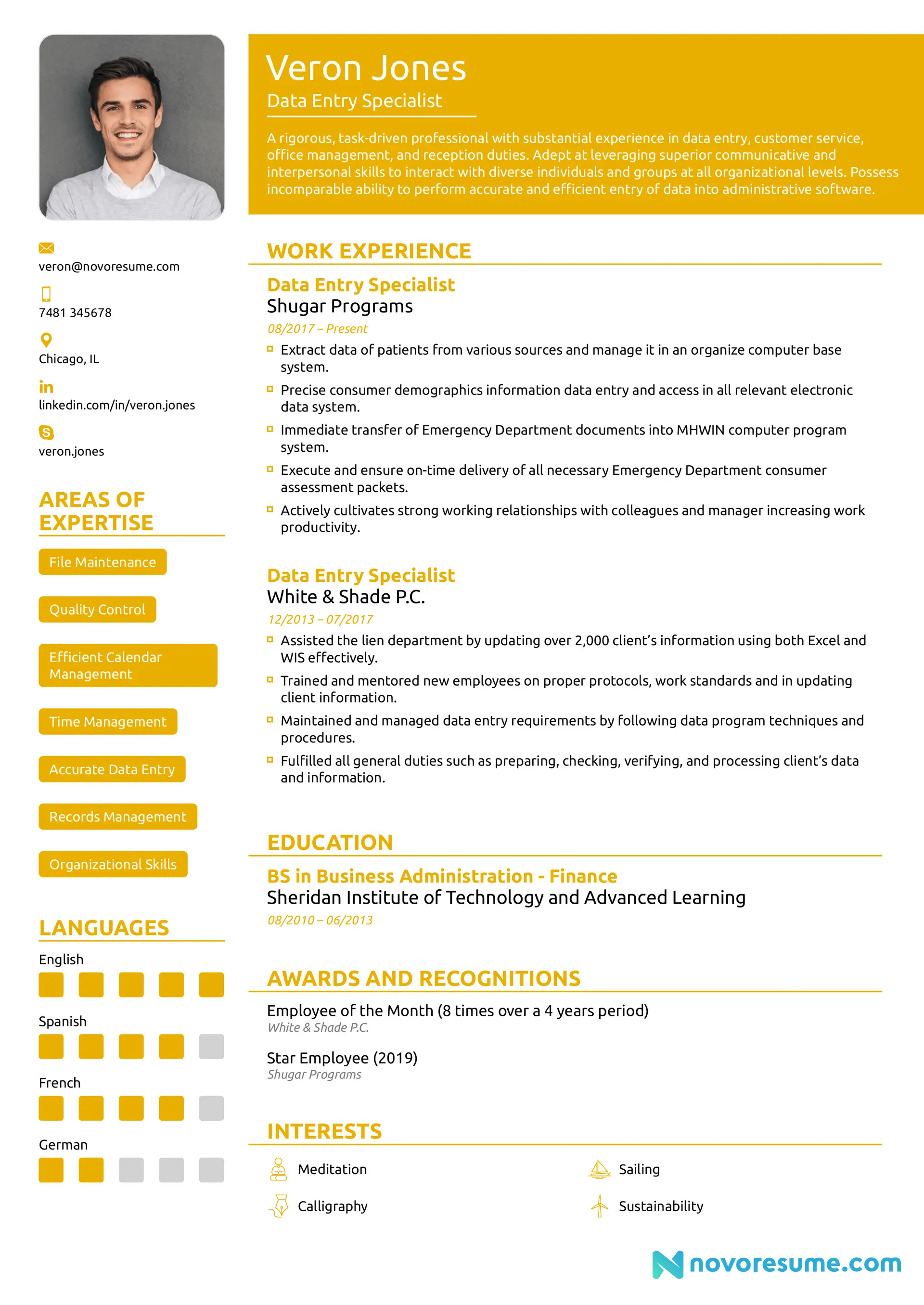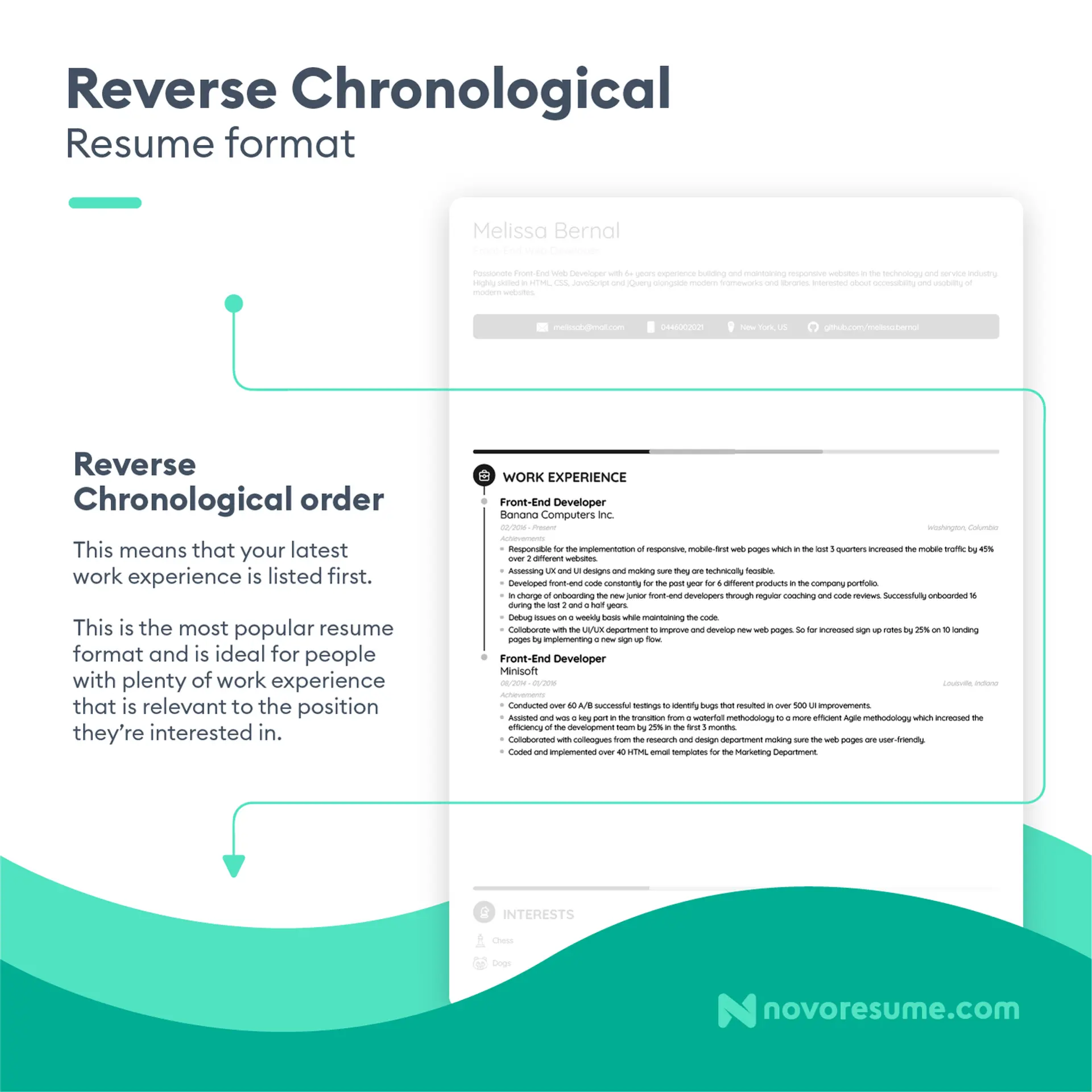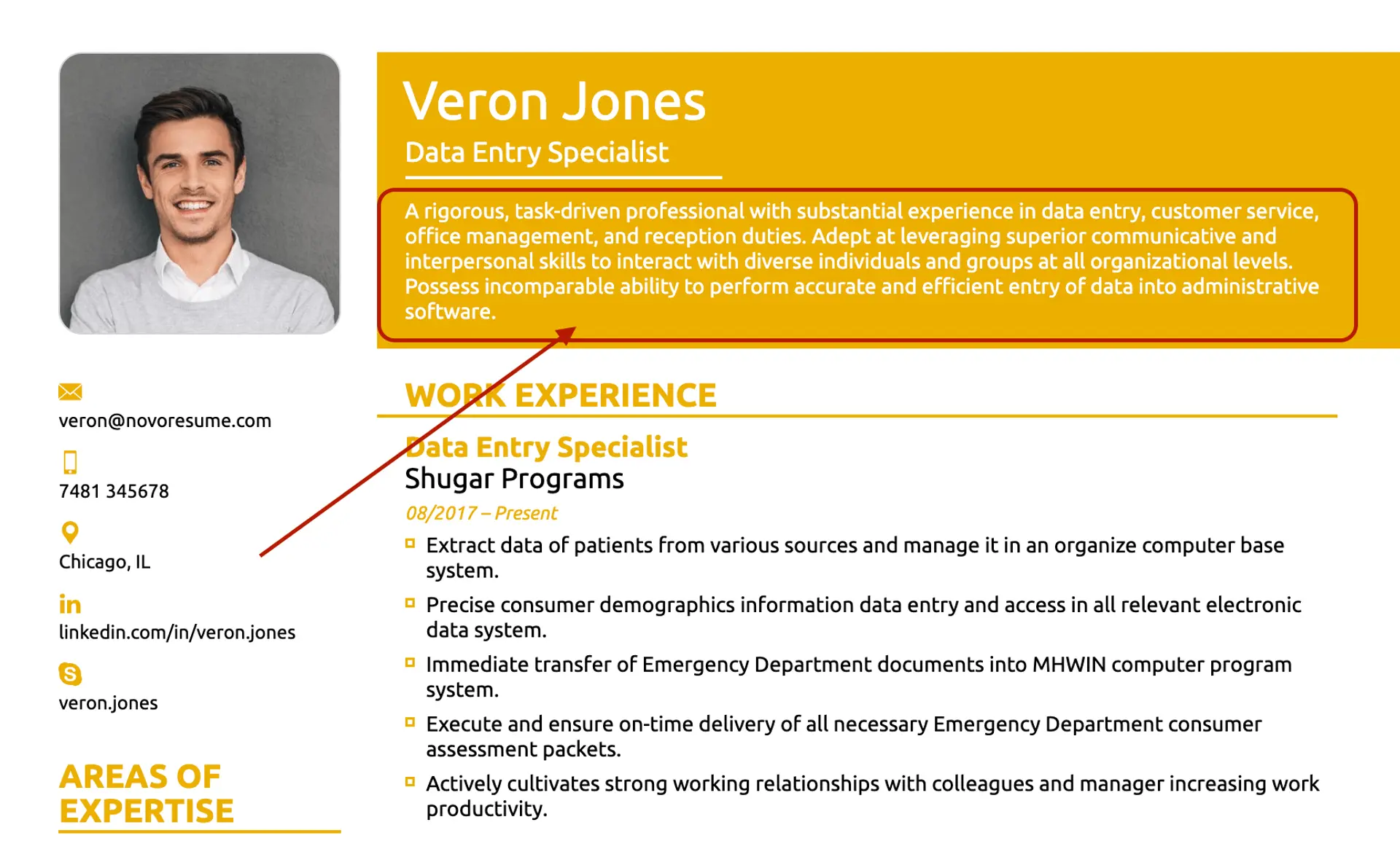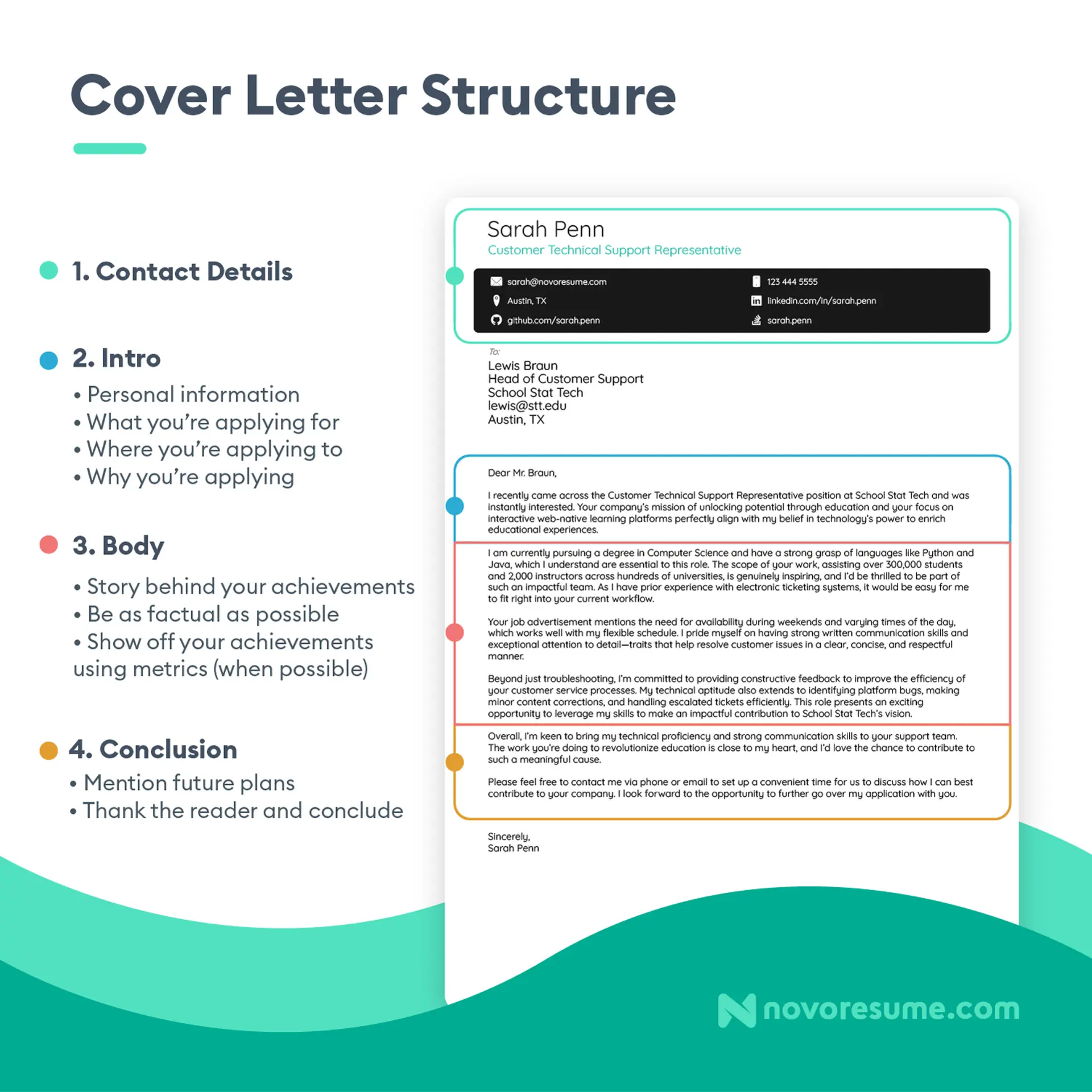
We’re living in a data-crazed world. And data is YOUR specialty.
Sure, you’re great with number crunching, but what about resume writing?
If you’re looking for your next data entry role, we’ve got just what you need: this guide is going to show you how to create the perfect resume to show off your skills and experience.
We’re going to walk you through the entire process of creating a data entry resume step-by-step!
In this guide, we cover:
- A job-winning data entry resume example
- What to include in your data entry resume
- How to give your data entry resume a special edge [with top tips & tricks]
Here’s some inspiration to get you started:
A data entry example, created with our very own resume builder:

Now, keep reading to learn how to create a resume that looks as great (or better) than the one above!
Not the right resume example for you? No worries, we've got you covered! Check out more of our resume examples below:
- Data Analyst Resume
- Data Scientist Resume
- Computer Science Resume
- IT Resume
- Artificial Intelligence Engineer Resume
- Web Developer Resume
- Software Engineer Resume
- Java Developer Resume
- Engineering Resume
How to Format a Data Entry Resume
First and foremost, you need to decide on the format of your data entry resume.
Like any career, employers want specific information to jump out at them when reviewing resumes. So data entry specialists need to make sure their resumes are formatted in a way that highlights this information.
In 2026, the most common resume format remains the “reverse-chronological” format. This is your number one choice.

Of course, there are other resume formats you can try:
- Functional Resume - This format emphasizes skills as opposed to professional experience. It’s good if you don’t have a lot of experience, are transferring to a new industry, or have gaps in your employment history.
- Combination Resume - The name says it all: a combination resume is a mix between “Functional” and “Reverse-Chronological.” It focuses both on skills AND work experience. The combination resume is great if you have a lot of work experience or you are trying to change industries.
Decided on your resume format? Now you need to get your resume layout right.
Here’s our recommendation…
- Margins - One-inch margins on all sides
- Font - Pick a font that stands out, but not too much. Good: Ubuntu, Roboto, etc. Bad: Comic Sans
- Font Size - Ideal font sizes are 11-12pt for normal text and 14-16pt for headers
- Line Spacing - Use 1.0 or 1.15 line spacing
- Resume Length - Keep your resume to a 1-page limit. Having trouble fitting everything into one page? Check out these one-page resume templates.
Pro Tip:
- As a data entry specialist you know very well that your performance is judged on speed and accuracy of inputting data. If you have impressive statistics on your past work, make them a focal point for your resume (more on this in the Resume Summary section below.
Use a Data Entry Resume Template
You’re probably used to writing your resume Word? Please, please STOP!
Using Word limits your ability to create a visually striking resume. Unless you are a true wizard, you could spend hours playing with fonts, colours and where to position different elements.
There’s a better way than using Word: use a data entry resume template.
What to Include in a Data Entry Resume
The main sections in a data entry resume are:
- Contact Information
- Resume Summary
- Work Experience
- Education
- Skills
If you want your resume to stand out more, you can also try these optional sections:
- Professional Certificates
- Languages
- Interests & Hobbies
Now, we’re going to go through each of those sections, and explain how to write them.
Still not clear on which sections to use? Check out our guide to What to Put on a Resume.
How to Get Your Contact Information Right
This section might seem like a no-brainer, but you’d be shocked at how many resumes we see where people have made silly mistakes to their contact information.
Like not including a country code in a phone number when applying for a job abroad, or using a silly email address.
For your contacts, include:
- Name
- Title - For data entry jobs, your best bet is likely “Data Entry Specialist” or “Information Clerk”.
- Phone Number - Double-check, triple-check this. One typo can really mess up your chances of an employer contacting you.
- Email Address - Use a professional email address (firstname.lastname@gmail.com); not the one you created way back in the 7th grade (mrcool1986@gmail.com).
- (Optional) Location - Applying for a job abroad? Mention your current location.
Correct Example
- Jennifer Smith - Data Entry Specialist. 101-358-6095. jsmith@gmail.com
Wrong Example
- Jennifer Smith - Data Geek. 101-358-6095. countrygirl2000@gmail.com
How to Write a Data Entry Resume Summary or Objective
Here’s something you probably didn’t know: recruiters spend less than 6 seconds reviewing a resume. Surprising, yes. But when you consider that a recruiter likely receives hundreds of applications, you can understand why.
So the lesson for you is this: if a recruiter can’t see you’re relevant for the job in a single glance, your resume won’t even be read.
What can you do to hook the recruiter the moment they look at your resume?
The answer is simple: use a resume summary or objective.
Both the resume summary and objective are sections that go on top of your resume, just under the contact information section.
But the resume summary and objective are not the same. The main difference between the 2 sections is that.
A resume summary is a 2-4 sentence summary of your professional experiences and achievements.

Remember the Pro Tip mentioned earlier? “If you have impressive statistics on your past work, make them a focal point for your resume.” The summary is a perfect place for you to immediately show off your achievements in data entry.
Data Entry Resume Summary Example
- Professional information clerk with 3 years experience working in data entry for the health-care sector. Proven ability to enter sensitive information with speed and accuracy, as evidenced by 99.2% accuracy record in previous role.
A resume objective, on the other hand, is a 2-4 sentence snapshot of your professional goals and aspirations.
Data Entry Resume Objective Example
- Recent computer science graduate seeking entry-level position that will support a career path in data analysis. Existing experience includes managing a customer database for a family-run business for the past year.
So, which one do you pick? A summary, or an objective?
As you can see from the examples, the main difference between the two is that a Resume Objective is relevant for those who are new to a field (student, graduate, or switching careers).
But those who are a bit farther along in their career paths will want to provide a Resume Summary.
How to Make Your Data Entry Work Experience Stand Out
What resume section is most important to employers? Work experience.
Recruiters want to see that you’ve applied your data entry skills in a professional environment.. Here’s how to structure your work experience section:
- Position name
- Dates
- Company Name
- Responsibilities & Achievements
Or, here’s what it looks like in practice:
Work Experience Example on Data Entry Resume
Information ClerkAlta Analytics01/2016 - 09/2018- Recorded demographic information based on customer surveys into Microsoft Excel spreadsheets.
- Achieved a 93% cumulative “success” rate for entering data based on speed and accuracy.
- Prepared customized reports for data analysts using Microsoft Excel.
Take a look at the second bullet point. Notice anything special? That’s right if you really want your resume to stand out, you should focus on talking about your achievements instead of just your responsibilities.
So, instead of saying:
“Entered data quickly and accurately”
Go for…
“Achieved a 93% cumulative “success” rate for entering data based on speed and accuracy”
The second one is more specific and immediately conveys an ability to succeed. It makes the idea of entering data quickly and accurately more tangible.
What if You Don’t Have Work Experience?
This is the most common concern expressed by students and recent graduates as they transition away from studying and try to find a job in data entry.
If you truly don’t have any formal work experience on your resume, list school projects, relevant courses you’ve taken or volunteer work. Try to highlight elements from your studies or extracurriculars that demonstrate your love for data, your savviness with computers and an attention to detail.
If you’re a student or recent graduate, you might want to check out our guide on how to make a student resume!
Use Action Words to Make Your Data Entry Resume SHINE!
“Helped”
“Created”
“Worked on”
Talk about boring words that you can find on just about any resume. Using these words when describing your work experience won’t exactly jump out at a recruiter.
Instead, use some of these power words to make your responsibilities and achievements stand out. These are just a few that are relevant to data entry specialists.
- Measured
- Analyzed
- Specialized
- Achieved
- Improved
- Created
- Adapted
- Modeled
- Programed
- Inventoried
How to List Education Right
The next section in any data entry resume is the “Education” section.
This one should be pretty simple: list out your educational experiences in reverse chronological order. Here’s how it should look:
Degree Type & Major
University Name
Years Studied
GPA, Honours, Courses, and any relevant projects or experiences.
Here’s a practical example :
Bachelor of Science in Computer ScienceUniversity of Toronto2014-2018- Relevant Courses: Advanced Excel, Introduction to Information Architecture, Designing Client Relationship Management Systems
- Collected and inputted student personal information into an existing database for the Computer Science Club
GPA: 3.4 / 4.0
Easy, right?
Before we move on, here are some of the most frequent questions we get about education on a resume. And, of course, their answers.
What if I’m not finished college or university yet, or I dropped out?
- You should still mention your degree. All you have to do is include the years studied. If you are still studying, put “Present” as the end date. E.g. 2018 - Present.
Do I list my high school education?
- Only if you don’t have a higher education. If you have a bachelor’s or master’s, it’s obvious you graduated high school.
What should appear first, education or experience?
- If you have any relevant work experience, then experiences go first. If not, education takes top spot.
Still have questions? Check out our guide on how to list education on a resume.
Top 30 Skills for a Data Entry Resume
A very quick way for recruiters to screen candidates is to scan resumes for skills. Obviously employers have specific skills in mind that are “deal breakers” if you don’t have them. This is why it’s important to have a comprehensive and easy-to-read skills section on your resume.
Not sure which skills to pick for a data entry position?
Here are just some of the common skills data entry specialists list on their resumes.
Hard Skills:
- SharePoint and advanced Microsoft Excel functions
- Spreadsheet design and maintenance
- Math (statistics and probability)
- Logic and analysis
- Relational databases (MySQL)
- Problem-solving and troubleshooting
- Pattern and trend identification
- Data mining and data QA
- Database design and management
- Business intelligence (BI)
- Risk management
- System administration
- Quantitative methods
- Data warehousing
- Regression analysis
- Data science research methods
- Experimental design & analysis
- Tech support
- Survey creation
Soft Skills:
- Critical thinking
- Attention to detail
- Risk assessment
- Training and instructing
- Organization
- Teamwork & collaboration
- Time management
- Efficiency
- Confidentiality
Pro Tip:
- As a general rule, we’d recommend not to go overboard with “Soft Skills” but if you have to choose just two for a data entry role, go with “Attention to Detail” and “Confidentiality”. The second is important if a job involves handling sensitive information.
Looking for a more comprehensive list? Here’s a mega-list of 100+ must-have skills in 2026.
Other Resume Sections You Can Include
Now that you’ve developed the core content sections of your resume, your work is done.
Well, not quite...
Remember that the #1 goal of your resume is to stand out.
And if your resume looks exactly the same as everyone else’s, then you’re less likely to be invited for an interview.
Remember that there could be a handful of other people applying for the same position who have identical credentials or similar career trajectories. Give yourself an edge over these people with these resume add-ons.
Professional Certifications
Adding a section for relevant professional certifications on your resume is valuable for differentiating yourself from other data entry specialists.
Let’s say you have certifications in database development or programming with specific languages. These are talents that an employer will immediately see as useful.
By including them on your resume you will tell the employer that you can do more than just furiously enter data into a spreadsheet should they need you to.
Languages
An extra language or two can always come in handy, even if it doesn’t have anything to do with the position you’re applying for. For example, maybe in addition to data entry, an employer will want you to support with data collection. This is where communication and language skills come in handy.
If you know any foreign languages and have extra space in your resume, feel free to add a language section.
Make sure to split the languages by proficiency:
- Native
- Fluent
- Proficient
- Intermediate
- Basic
Interests & Hobbies
There is a bit of a stigma around data entry specialists that all they need to do is enter vast amounts of data into a spreadsheet with speed and accuracy.
Yes, this is true, but these people are not robots. They have diverse skill sets and interests.
Some of these interests can be directly relevant to an employer, especially if they relate to computers.
Meanwhile, employers are in the business of hiring people who will work well with others. Your compatibility with other team members is important for a well-functioning workplace.
People bond and come together around interests, so why not list these on your resume to show you fit with the team?
Not sure which hobbies & interests you want to mention? We have a guide for that!
Match Your Cover Letter with Your Resume
You might be thinking, “Oh no, I have to write a cover letter for this data entry position?! Don’t the skills and experiences on my resume speak for themselves?”
Sorry, but cover letters are still very important.
They show the recruiter that you’re passionate about working for THIS position in THIS company, and you aren’t just sending your resume all over the place.
Including a cover letter that is targeted to specific employers along with your resume can significantly boost your chances of being invited for an interview.
And the first step to writing a convincing cover letter is to get the structure right. Here’s how to do that:

And here’s what you’d write in each section:
Contact Details
- Your personal contact information, including full name, profession, email, phone number, location.
- Hiring Manager’s Contact Information - Full name, position, location, email
Opening Paragraph
- Your introduction should be very strong. If you don’t manage to hook the hiring manager here, chances are, they’re not going to read the rest of it. So, mention…
- Your name
- The position you’re applying for
- Your experience summary and top achievement
The Body
Once you’ve got the hiring manager hooked, you can go through the rest of your background. Some of the points you can mention here are:
- Why you want to work for this specific company
- Anything you know about the company’s culture
- What are your top skills and how are they relevant for the job
- If you’ve worked in similar industries or positions
Closing Paragraph
This is where you:
- Wrap up any points you missed in the body paragraph
- Thank the hiring manager for their time
- End with a call to action. Something like, “I’d love to further discuss how my experience as an X can help the company with Y”
Formal Salutations
- Use a formal closing, such as “best regards” or “Sincerely.”
Need more inspiration? We get it - creating a cover letter is very hard work. But don’t worry, we’ve got you covered with your step-by-step guide on how to write a cover letter.
Key Takeaways
And that’s a wrap!
If you’ve followed all of the advice above, your resume and cover letter should be ready to rock. You’ve set yourself up for success in your job search.
But just to recap, let’s go through some key takeaways from what we covered:
- Choose the right format for your data entry resume. A reverse-chronological format is your best bet. And follow the best practices we described for getting the resume layout right.
- Every resume needs either a resume summary or objective to catch the hiring manager’s attention.
- Focus on your achievements in the work experience section as much as possible instead of just describing responsibilities.
- Use “power words” that convey action.
- Hard skills are more important than soft skills on a data entry resume.
- Create the perfect pair by matching your data entry resume with a cover letter tailored to the position and company you’re applying for.
Suggested Reading:
